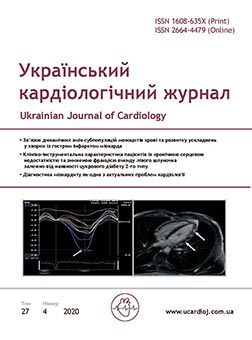Comprehensive intervention approach to the diagnosis and treatment of a patient with coronary artery disease and subclavian-vertebral robbery syndrome
Main Article Content
Abstract
The aim – to analyze of the complex treatment of a patient with coronary artery disease and subclavian-vertebral robbery syndrome, diagnostic methods of examination, observation and treatment.
Materials and methods. The patient with coronary artery disease and occlusion of the left subclavian artery. Physical assessment methods were used? Such as: examination of the patient, anamnesis; laboratory and instrumental investigations – general blood analysis, biochemical blood analysis, electrocardiogram, echocardiography, coronary angiography of the carotid and subclavian arteries.
Results and discussion. This complex interventional method of treating the patient had rather good angiographic result. The implantation of the stent system into the area of critical lesion of the main left coronary artery and stent system in the occlusion of the left subclavian artery led to avoid the open surgical operation in the patient and to reduce the period of rehabilitation with a low postoperative risk.
Conclusion. According to the international experience, in cases of planned phased treatment of coronary and peripheral arteries that require surgical intervention, it is better to give preference to the endovascular technique in patients with hemodynamically significant lesions. Percutaneous transluminal angioplasty and stenting should be the first therapeutic method for eliminating the problem of symptomatic lesions of the coronary and peripheral arteries.
Article Details
Keywords:
References
Caesar-Peterson S., Qaja E. Subclavian Artery Stenosis // StatPearls [Internet].– 2019.– June 18. doi:https://doi.org/10.1136/hrt.2004.048744.
Epperla N., Ye F., Idris A. et al. Treatment-Related Cardiovascular Outcomes in Patients with Symptomatic Subclavian Artery Stenosis // Cureus.– 2017.– Vol. 9 (5).– P. e1262. doi:https://doi.org/10.7759/cureus.1262.
Herrington W., Lacey B., Sherliker P. et al. Epidemiology of atherosclerosis and the potential to reduce the global burden of atherothrombotic disease // Circulation Research.– 2016.– Vol. 118.– P. 535–546. https://doi.org/10.1161/CIRCRESAHA.115.307611.
Hesarur V. Successful percutaneous intervention for chronic total occlusion of left subclavian artery // Interv. Cardiol. J.– 2017.– Vol. 3, N 3.– P. 70 https://doi.org/10.21767/2471-8157.100070.
Iared W., Mourão J.E., Puchnick A. et al. Angioplasty versus stenting for subclavian artery // Cochrane database of systematic reviews (Online).– 2014.– May. https://doi.org/10.1002/14651858.CD008461.pub3.
Jahic E., Avdagic H., Iveljic I. Percutaneous Transluminal Angioplasty of Subclavian Artery Lesions // Med. Arch.– 2019.– Vol. 73 (1).– P. 28–31. doi: https://doi.org/10.5455/medarh.2019.73.28-31.
Rafailidis V., Li X., Chryssogonidis I. et al. Multimodality imaging and endovascular treatment options of subclavian steal syndrome // Can. Assoc. Radiol. J.– 2018.– Vol. 69 (4).– P. 493–507. https://doi.org/10.1016/j.carj.2018.08.003.

